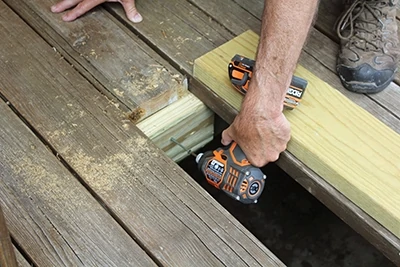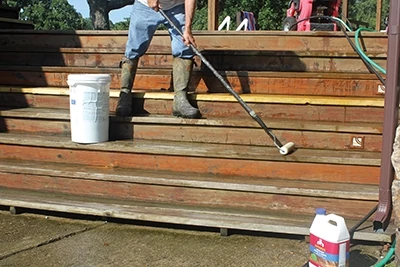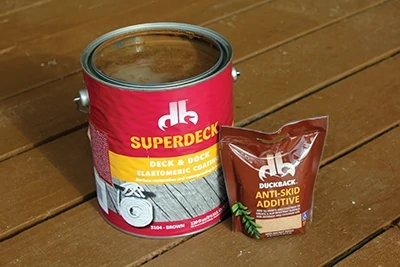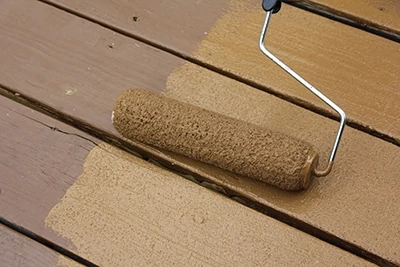By Monte Burch
When our deck weathered to splits and splinters we had a major problem. With more than 1,800 square feet of decking surrounding an above-ground pool, a number of the boards had also rotted. We didn’t want to rebuild the entire deck, nor install new composite decking because most of the deck boards were still solid but weathered. Although an awning protected the ends of the boards close to the house, their outer ends were badly weathered. Rather than replacing the entire 16-ft. boards, we only wanted to replace the weathered sections. However, recoating the new sections with a deck stain/preservative wouldn’t match the old boards, even with a number of coats.

The solution was Superdeck Deck & Dock Elastomeric Coating. This high-build coating is designed to protect, resurface and waterproof old damaged wood and concrete. The unique formula provides long-lasting protection against moisture and the damaging effects of the sun.

It is designed to expand and contract along with the substrate while offering excellent scuff-resistance for heavy-duty foot traffic areas. Deck & Dock Coating will also lock down splinters and bridge dimensionally unstable cracks on old damaged wood surfaces. The product is formulated to resist growth of mildew and algae on the coating’s surface.

Because our deck surrounded a pool, we also utilized Deck & Dock Anti-Skid additive. It creates a great slip-resistant surface to the deck and stair treads.

Repair and Preparation
First step was to check the deck framing. All support boards were in good shape, with only the deck boards weathered. Because the pool-deck had a railing section to keep toddlers from falling into the water, it had to be removed before recoating.

The next step was to locate and mark the rotten or soft deck boards. Some you could feel when walking across. We used a sharp knife to probe doubtful boards.

A knife blade was used to probe between the deck boards to locate the joists, and mark their locations. We then used a Stanley Quick Square to mark across the boards on the front side of the joist.

We bored starter holes at the corners of the mark with a paddle bit and then used a saber saw (jigsaw) to make the cut. In the case of multiple boards, we made a pocket cut with a circular saw followed by a saber saw to finish. The old screws were then removed and the old boards pried up and out.


We fastened short sections of 2×6 on the cut side to the existing joists. We then cut the replacement boards to length and screwed them in place.

Where board ends are at an angle, use the old board to mark the proper cut line.

Note: If possible, position new deck boards with the crown facing up so water will run off. For this reason, be selective in purchasing so you have a good recognizable crown side. Examining the end of the board will reveal the crown.

The pool railing sections as well as the outside railings and benches were given fresh protective coatings using Superdeck Transparent Stain. The stain is a high-solids, professional-grade wood finish. The stain uses high-quality pigments to inhibit damage caused by the sun, a three-oil system to provide superior protection, and a highly effective mildewcide to inhibit mildew growth on the coating surface.

The deck took more time preparing to finish than we had planned, but finally we were ready to apply the Deck and Dock coatings. The entire deck area was lightly power-washed, as well as the house siding adjoining the deck.

Test a small area by scrubbing with a brush to determine if the surface is ready for rinsing. When ready, scrub the surface with a firm bristle brush or long-handled push broom. Rinse thoroughly with water using a garden hose or pressure washer. Do not exceed 1,000 psi when using a pressure washer. Rinse any residue from plants.

Applying the New Coat
Finally, the fun part—applying the finish coatings. The product should not be thinned and goes on fairly thick. It can be applied with a brush, roller or airless sprayer. When rolling, use a 3/8-in. nap synthetic roller cover for smooth surfaces, use a 1/2- to 3/4-in. nap for medium texture, and a 1-1/4-in. nap for a heavily textured finish.


Back-rolling is suggested when spraying, working the finish smoothly and evenly to avoid lapping. Always apply a bit of product to a test area and allow to dry completely before coating an entire project to test for color and appearance.

The product should not be applied in the extreme heat of the day. Unfortunately, our deck faces south and we did the job in mid-summer. I discovered we had to work only in early morning, the product dried too quickly to prevent lap marks in the hot sun. Two coats are recommended in order to fill the large, 1/4-in. cracks. And, in a couple of areas we had to apply a third coat. Because the material goes on fairly thick you must brush between the deck boards to cover the sides of the joints.

Coverage may vary, but in most cases it will be 100 square feet per gallon for application of 1 to 2 coats. When filling deep cracks or locking down splinters on old, extremely damaged wood surfaces, additional coats may be required. The product comes with a limited lifetime warranty.

The Duckback Anti-Skid additive was added to the last coat, although we used it in two coats on the stair steps. The product, made of ground walnut hulls, is mixed one packet to each gallon of finish.


After the main deck was coated, we cut trim pieces to go around the awning posts and the pool edge. These pieces were precoated, then fastened in place. The pool railings were then reinstalled. We had discovered a lot of rot on the deck boards under the railings, so we raised the railings slightly with wood blocks.

The end result is that our deck looks great and has a new life.








